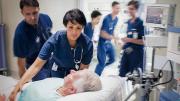We like to think of modern medicine and doctoring as scientific. And so they are, but health outcomes remain subject to chance like every other aspect of life: the heart attack patient who dies despite expert EMT care because road construction delays the ambulance’s path to the hospital that afternoon. That example appears early in Random Acts of Medicine: The Hidden Forces That Sway Doctors, Impact Patients, and Shape Our Health (Doubleday, $30), by Anupam B. Jena, Newhouse professor of healthcare policy, and Christopher Worsham, instructor in medicine—both physicians. From chapter six, on the relative merits of action versus inaction:
If pressed, most physicians will admit that they err on the side of more medical care. We ourselves are not immune to it. We’ve given antibiotics when we were pretty sure an infection was viral and didn’t require them; we’ve tested for all kinds of rare and exotic diseases, even when we know the chances of the patient having the disease were extremely low (what some refer to as the “shotgun” approach to diagnosis); we’ve ordered CT scans of every part of the body without expecting to find anything, “just in case.” Most of the time, this care ends up being unnecessary. But every once in a while, what is “unnecessary” yields a finding that saves a life, and the tendency toward more care is reinforced.
How do we solve this conundrum? As the Harvard cardiologist, writer, and national correspondent for The New England Journal of Medicine Dr. Lisa Rosenbaum has written, “Perhaps the most accurate conclusion is that sometimes less is more, sometimes more is more, and often we just don’t know.” It’s a frustrating view of the situation, but as practicing doctors we can’t deny its truth. All we can do is, through continued study and research, try to illuminate the gray areas, in hopes that in time they can be made more black and white.
In the meantime, we’re reminded of a piece of med school advice from a seasoned trauma surgeon evaluating a clinically unstable patient—a quotation originally attributed to a 1940s theater producer frustrated with an overacting cast member: “Don’t just do something: stand there!” Most doctors would have to acknowledge that this is sage advice, if hard advice to accept. Because when you’re standing at the foot of a bed, looking at a patient facing life or death, and you’re asked, “Doctor, what should we do?” often the hardest answer to give is, “Nothing. Let’s just keep watching for now.”









